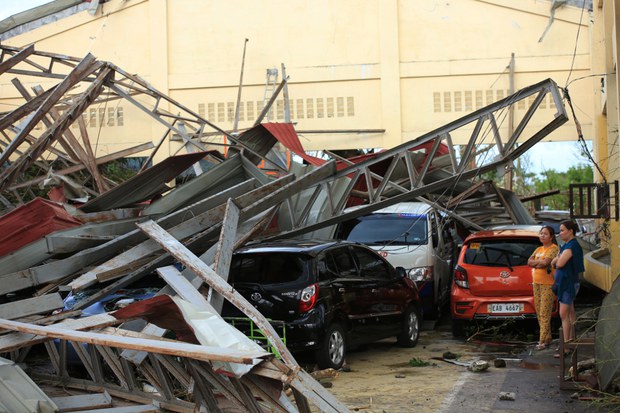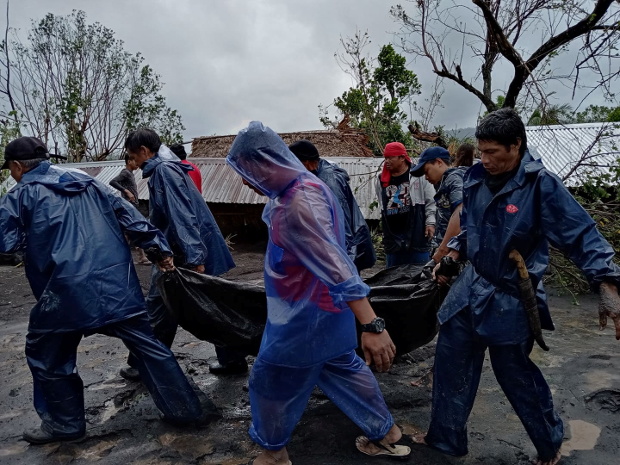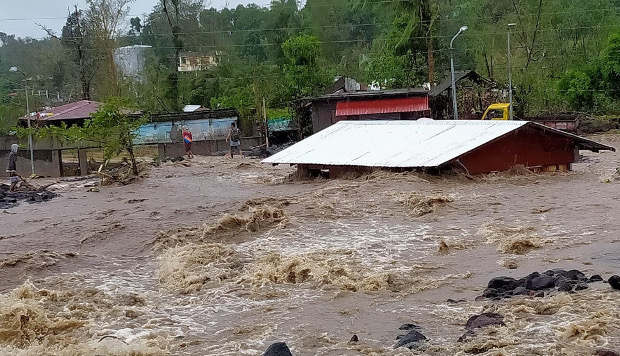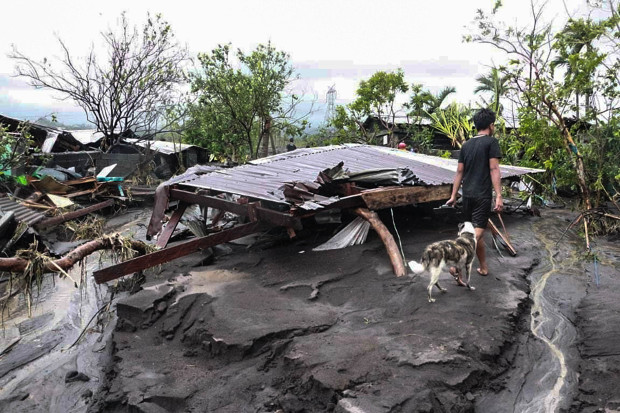Philippines Battered by Year’s Strongest Typhoon
2020.11.01
Manila and Dagupan, Philippines
 Residents stand next to cars damaged after a gymnasium collapsed at the height of super Typhoon Goni after it hit Tabaco, Albay province, south of Manila, Nov. 1, 2020.
Residents stand next to cars damaged after a gymnasium collapsed at the height of super Typhoon Goni after it hit Tabaco, Albay province, south of Manila, Nov. 1, 2020.
The world’s strongest typhoon this year raked across the Philippines Sunday, triggering floods and mudslides and killing at least ten, officials said.
Super Typhoon Goni, locally known as Rolly, made landfall on the island province of Catanduanes around 4:30 a.m. with sustained winds of 225 kilometers (140 miles) per hour and gusts up to 310 kilometers (193 miles) per hour.
It moved west at around 25 kilometers (15 miles) per hour, with nearly 20 million people on its path, including the capital, Manila.
Around 7 p.m. local time, Goni was packing sustained winds of 125 kilometers (77 miles) per hour, and stronger gusts, with the center of the storm passing across the island of Mindoro, some 165 kilometers (102 miles) south of Manila, forecasters said.
The storm came on the heels of Typhoon Molave, which passed through the same areas as Goni and left more than 20 dead, according to disaster relief officials.
Meanwhile, a new tropical storm, dubbed Astani – or Siony, locally – was brewing east of the Philippines, with forecasters warning it could hit northern Luzon at mid-week.

‘There were some missing people’
In Albay – on Luzon’s southeast coast– rains were so strong early Sunday that visibility was reduced to a few meters, provincial Governor Al Francis Bichara said over ANC cable television.
“This is probably the strongest storm I have seen my entire life,” he said. He said power and telecommunication services were cut, and that the province had evacuated some 150,000 residents out of harm’s way.
By nightfall, civil defense officials in the region said ten people had died, all from Albay, and more than 390,000 people had been displaced there.

Hazel Panelsa, a resident of San Francisco village, in Guinobatan, Albay, appealed for help as some people who had refused to evacuate were trapped in their flooded homes.
“Houses were covered by floodwaters…there were some missing people,” she said.
Water dislodged dried debris from the slopes of the 2,463-meter (8,080-foot) Mayon Volcano, sending it cascading down and destroying dikes, officials said. In 1814, the village of Cagsawa was buried when Mayon erupted and a powerful typhoon called Durian caused mudflows that killed nearly 2,000.

Millions expected to be displaced
By late Sunday afternoon, strong winds whipped Manila and outlying areas. Forecasters described them as “violent winds” accompanied by strong rains.
The National Disaster Risk Reduction and Management Council (NDRRMC) said millions of people were likely to be affected.
“Our predictive analytics reflect between 19 million and 31 million individuals will possibly be affected by the storm, based on the population count in the areas within the typhoon track,” NDRRMC spokesman Mark Timbal told reporters.
Military chief Gen. Gilbert Gapay said around 4,000 soldiers, 2,000 militiamen, and a thousand reservists had been mobilized to help evacuate residents in the path of the typhoon.
Troops were also placed on red alert status to maximize the availability of military personnel in preparation for the possible devastation caused by Typhoon “Rolly.”
“We are closely working with local officials and we have activated our joint disaster task force,” he said.
In evacuation centers, the Governor of Aurora province, Gerardo Noveras, said enforcing physical distancing protocols in evacuation centers was a “big challenge.”
“There are factors that are out of our control and cannot be remedied like limited space in evacuation centers where many need to be housed,” Noveras said.
“We will make certain that in those situations, evacuees who will be brought to the shelters are wearing masks, so they will still have protection. In case someone in the evacuation center is asymptomatic or is an unreported positive case, they won’t be easily infected,” Noveras added.
The Philippines has recorded 383,113 infections and 7,238 deaths during the coronavirus pandemic, according to infectious disease experts at Johns Hopkins University in the United States.

‘Much more complex’
About 20 tropical storms and typhoons batter the Philippines each year, some of them devastating.
In November 2013, at least 7,000 people died and scores were reported missing after Super typhoon Haiyan slammed into the central Philippines, causing massive storm surges.
Senator Richard Gordon, who is also the chairman of the local Red Cross, said the government had prepositioned emergency response teams, first aid, hygiene kits and other relief supplies as the storm approached.
“This ordeal is not new to us. We have learned through experience about the need to be prepared, and the importance of ensuring communities get the support they require in the hours and days after a typhoon hits,” he said.
![201101-PH-typhoon-4-620.JPG Rescuers relocating vulnerable people living near Manila Bay to a safer place as Typhoon Goni, the most powerful storm to strike the Philippines so far this year, barrels towards the heavily populated city, Nov. 1, 2020. [Handout/City of Manila]](/english/news/philippine/typhoon-goni-11012020105209.html/201101-PH-typhoon-4-620.JPG/@@images/fcdd96d8-6901-453f-b5cc-e309126e9161.jpeg)
He conceded, however, that the COVID-19 pandemic “has made this much more complex” with disaster relief officials anxious to make sure that transmissions do not occur in tightly packed evacuated centers.
“We have been preparing for this situation, training and equipping our teams for a COVID-era response,” Gordon said.
“Right now our staff and volunteers are where they need to be, supporting search and rescue efforts, providing meals, and distributing relief packages to people who have been evacuated or tragically lost their homes,” he stressed.
Jeoffrey Maitem reported from Cotabato City in the southern Philippines and Jojo Rinoza from Dagupan, north of Manila.







